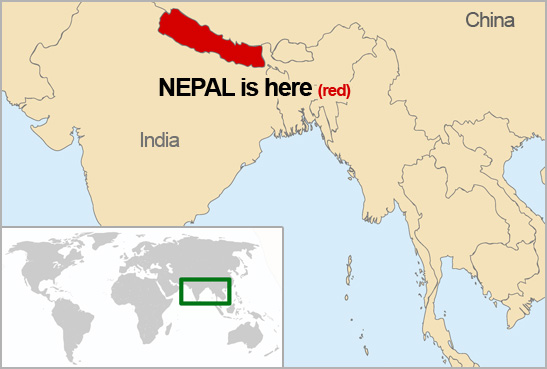Where in the world is Nepal?
The country Nepal is pronounced as NAY PAHL. It is a land locked mountainous kingdom in southern Asia, located between India and China.
Currently over 26 million people of different races and tribes, living in different regions, wearing different costumes and speaking different languages occupy a total of 147,181 square kilometer (885 km east to west, and 193 km north to south) of this tiny country.
Nepal is one of the world’s poorest countries, about half the population of Nepal lives below the poverty line.
Nepal is a little larger than North Carolina State of America. Nepal is geographically, culturally, and linguistically diverse. The capital of Nepal is ‘Kathmandu’ but many love to call it by the name Catmandu or Woodmandu or simply by the name `city of temples. Nepal is a kingdom of Himalayas, artistic monuments, exotic wildlife, and a unique harmony of diversified cultures.
Nepal attracts visitors for casual holidays, tours, and adventure activities including `Everest Expedition’. Nepal is also popular for having it’s land the birth place of Lord Buddha, and birth place of Lord Sita. Agriculture and Tourism are two important revenues that keep this nation in existence. Nepal’s main economy is driven by its tourism, agriculture, and many Nepalese men are laborers working in foreign countries.
Religions of Nepal:
87% Hinduism, 8% Buddhism, 4% Islam, 1% other (Christianity is growing quickly)
Himalayas of Nepal
- Nepal has more than 200 mountains
- Himalayas of Nepal is known as the rooftop of the world. Because the world’s highest mountain (Mt. Everest) is also located in Nepal
- Nepal is known as a Himalayan Country
- Himalayas are regarded as the most beautiful part of the earth which is often accurately named as the Clouds of The Earth or as The Location Where The Earth Meets The Sky.
- Himalayas is the King of Mountains. It has more tallest mountains than any other regions of the planet
- Over a 1000 mountain expeditions takes places every year in Nepal, each expeditions carrying an average of 30 people, more than 80% of those expeditions are towards the Himalayas.
